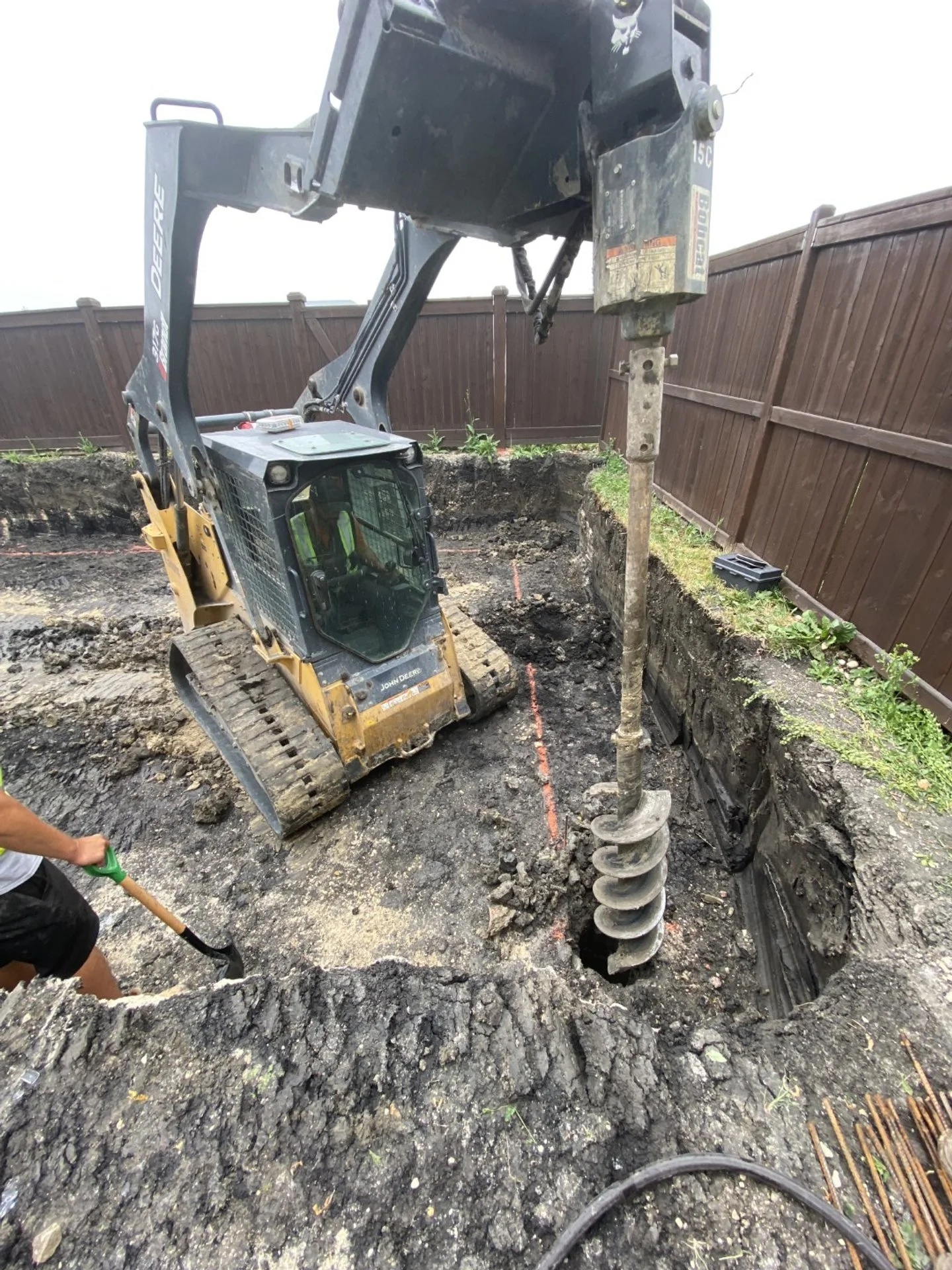These 3 Things Could Save You $85,000 (In Repairs) On Your Inground Pool Build
When you are shopping for an Inground Pool builder in Winnipeg, you may think that all pool builders build an Inground pool the exact same way, but this is not the case. This is why prices can vary from one builder to another. This is why to make sure three important components are included in your Inground pool or it could cost your thousands later on. Scroll down to see them now.
So let’s get the basics out of building a decent Inground pool out of the way. Ok a good Inground pool builder will mark the pool out in the proper location with the right elevation. They should dig the pool properly following the panel and slope layout. When building the pool they make sure the pool steel is level at the right elevation and the panels are flush and straight. The pools diagonals must be adhered to or the liner won’t fit. A concrete collar of at least 10” high around the pool, aslo called a footing or bond beam, to cement the panels in so they won’t move. Then a decent builder would plumb the pool properly then pressure test all the lines to make sure the glue joints hold under pressure. After that they would use proper backfill, which is pea gravel or sand, around the plumbing and 3/4 limestone above that. They will bond the pool with copper grounding wire and use conduit or Teck90 for any underground wire. Then a decent Inground pool builder would use a proper trucked in pool floor mixture for proper consistency and trowel the pool floor evenly. Then they would install the liner with no wrinkles in the pool. The vinyl covered steps or VOS should have only small wrinkles, or puckers, only around the steps as this is inherent in the welding. There should not be any large wrinkles throughout the steps. Then the plumbing of the pad would look tidy and neat. Professional gas and electrical trades should be used to connect the equipment to the utilities. The pool should properly circulate and function when turned on. All the water features should be tested and adjusted for proper performance and appearance. The concrete deck should be properly sealed. When the pool is finished you should see an beautiful Inground pool that looks great and heats up. These are the basics of a decent pool inground pool builder. But what are we missing?
Inground Pool - Completed and Testing
WINNIPEG WINTERS ARE BRUTAL ON INGROUND POOLS
An Inground pool is not just “ Pretty with Water” it must last decades. How long will that pool last before you see issues with the construction. In Winnipeg, our winters are brutal on structures just look at our roads and driveways. Just look at homes that have structural and foundations problems. In the winter months Winnipeg and the province of Manitoba have frost typically 6’ but as much as 8’ deep. Even though we have extreme cold temperatures in winter our melting starts in April and is over by the middle of May. So we get about about 4 weeks melting or less. So the snow melt is typically fast and ground water is very high in those 4 weeks. This quick thaw typically causes overland flooding almost every second year in many low lying areas through Manitoba. So we need to make sure your Inground pool has as many safeguards against these environmental conditions.
Over 30 years in the pool business I have been asked by many clients to quote on renovating their existing pool. I have seen decent work and I have seen structural pool failures, liner problems and concrete pool decks failing. Fortunately my experience has taught me that you can avoid many of these issues by installing three very important construction components; CONCRETE PILES UNDER THE POOL WALL, a proper WEEPING TILE GROUND WATER CONCTROL SYSTEM and INTEGRAL STEEL DECK SUPPORTS. Each of these items play an important role in prolonging the life of your pool. When shopping for an Inground pool you need to ask if these items are included, in the build price, as they can save your pool from structural failure and future liner issues. Remember there is no “STANDARD” for building an inground pool, so it is up to you to ask what is included. Also if a pool quote is lower than another quote, check is these items are included because they add approximately $7,500 to $10,000 onto the price of a typical pool.
1/ CONCRETE PILES INSTALLED UNDER THE POOL WALL
Drilling 10 feet deep holes for concrete piles.
One of the most important construction components that should be installed in your inground pool are CONCRETE PILES UNDER THE POOL WALL to help prevent the pool from sinking. Without concrete piles I have seen pools sink 6” after only three years of being installed! I have also seen pools only slightly sink after twenty years. You actually never can tell with Manitoba’s soil conditions and ground water issues, so it is better to be safe than sorry.
If a pool has sunk, it is not level and it may not operate properly. It is also looks not right as the water is level but the pool is not. A basic fix will cost you about $25,000. It is alot of work, we need to remove the pool deck, remove the liner, install new steel on the low side then replace the deck and new liner. But without ripping the steel out and drilling for piles, the pool could keep sinking. I have seen this exact problem. Years ago, a client of mine asked me to quote on fixing his sinking inground pool. He spent $25k initially, with another pool company, to renovate his sinking pool. He never installed piles. Only three years after the renovation it kept sinking and he had to make the costly decision to fix it right. We had to completely remove the deck again, remove the liner again, rip out the pool steel, drill piles, replace the steel, replace the liner and then a new pool deck. Ultimately a new steel pool was installed. The renovation bill was about $85,000. So they could have saved $110,000 total, if they installed piles for only $5,000 when the first purchased the pool.
Installing concrete piles is not complicated. Our process is to drill the piles during stage one of excavation. We already have the compact track loader on site and drill attachment. We excavate the whole pool to shallow end depth also called shelf height. Then we pause excavation and drill all of the 10’ deep holes for piles. We fill the holes with concrete immediately and add the rebar. We are well below the frost line. Since the holes start at shallow end depth, the piles go to approximately 14’ deep which is well below the 8’ frost lines. This gives the pool wall a solid foundation to sit on. After the piles are filled with concrete, we will finish stage two of the excavation which is cleaning up the tailings and digging the deep end. The next step is we erect the steel walls and they sit on top of the piles. A concrete collar is installed around the pool to cement the steel and pile together.
Prestige includes concrete piles with our Ultimate Inground Pool package. Some pool companies wait until dig day to see if silt is present and then they sell you piles at that time for $5,000. But it’s best to get them included not just for silt but also for long term structural support. A pool company that installs piles as a standard item is looking out for your longevity of your pool. Just like having you home built on piles, a pool should be built on piles. Second to your home, an Inground pool might be the most expensive purchase you make. So it is wise to build your pool properly and protect your investment.
2/ WEEPING TILE GROUND WATER REMOVAL SYSTEM.
Weeping tile with black sock installed with pea gravel.
If you are a Winnipegger, and grew up in the 80’s, you may know the jingle “A-B-A-L-O-N, Abalon!” they started 50 years ago repairing foundations in Winnipeg homes and it was great business. This was due in part to homes not having a proper ground water removal system installed in the 50’, 60’ 70’ and 80’s. Sump pumps became code in the 1990’s and all newer homes have now them. Many of those homes had foundations problems because of ground water that would sit against the basement walls, the clay would expand and crack the walls when it froze. Then water would seep into the basement when it rained or in spring from snow melt. Just as your home needs a ground water removal system so does your pool. You need to get water away from the pool walls to prevent damage. A proper ground water protection system for the pool consists of a continuous weeping tile around the pool, connecting back to a sump pit. An sump pump with float is installed in the pit for automatic evacuation of the water. The weeping tile typically has a sock around it and pea gravel is surrounding the tile. By having this system installed you are helping to prevent two things, structural pool damage and a floating liner. With this system the water doesn’t accumulate around the pool steel. So in winter you won’t get swelling of frozen water from pushing your walls in. Plus in the Spring when snow melts, the ground water protection system eliminates the water around the pool so it won’t go under the liner and lift the liner. So a proper ground water protection system prevents water damage and floating liners
3/ INTEGRAL STEEL DECK SUPPORTS
When you install a pool you must over dig the pool at least 2’ on each side in order to install the A-Frames at each steel wall panel joint. The A-frames are always part of any pool steel kit and not to be confused with INTEGRAL STEEL DECK SUPPORTS. Sometimes referred to as X-Frames, these deck supports are two pieces of 12 gauge galvanized steel that are installed on the outside of the pool wall approximately every 2 feet around the perimeter of the pool before we concrete the pool in. The reason we install the deck supports is they span the void of the 2’ of ground we removed when we over dug the pool to hold up the pool deck. These definitely cost more to add to any pool price and they take extra labour time to install. Many people believe that backfill may hold up the deck, but backfill always settles and there is a gap under the pool deck. This gap is hollow and without any support your expensive concrete deck could crack and sink. The integral steel deck supports provide support for your deck to prevent cracking and shifting of your deck.
How you build a quality Inground Pool is learning from experience. It’s adding structural and preventative components that help prevent future issues. The best guarantee against “Acts of God” or mother nature is to build the pool right in the first place for your regional outdoor conditions. Winnipeg, and Manitoba, have very different climate conditions than Ontario or BC. You must build for your regional conditons. This comes from experience and using the best techniques available. Some may say it’s overbuilding, but I say it’s doing it right the first time! That gives me and my clients peace of mind!









